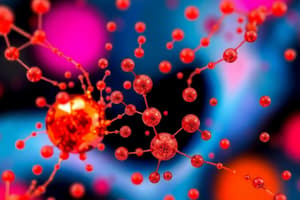Podcast
Questions and Answers
What method is used to analyze the grafting density of nanoparticles?
What method is used to analyze the grafting density of nanoparticles?
- Ultraviolet-Visible Spectroscopy (UV/Vis)
- Atomic Force Microscopy (AFM)
- Thermogravimetric Analysis (TGA) (correct)
- Transmission Electron Microscopy (TEM)
During the TGA analysis, which temperature is mentioned for determining the residual mass of pure gold nanocrystals?
During the TGA analysis, which temperature is mentioned for determining the residual mass of pure gold nanocrystals?
- 600 °C
- 400 °C
- 200 °C
- 500 °C (correct)
In the sedimentation velocity AUC experiments, what is the purpose of monitoring at 525 nm?
In the sedimentation velocity AUC experiments, what is the purpose of monitoring at 525 nm?
- To determine the size of the nanoparticles
- To detect sample impurities
- To assess the polymer concentration
- To monitor the sedimentation coefficient (correct)
How is the number of polymer units per total sample derived in grafting density calculations?
How is the number of polymer units per total sample derived in grafting density calculations?
What tool is used in TGA to determine the grafting density of the samples?
What tool is used in TGA to determine the grafting density of the samples?
What is the significance of the polymer molecular weight in the calculations?
What is the significance of the polymer molecular weight in the calculations?
What concentration range of salt is used to induce aggregation in nanoparticle samples?
What concentration range of salt is used to induce aggregation in nanoparticle samples?
What function does the ImagePro software serve in the analysis of the nanoparticles?
What function does the ImagePro software serve in the analysis of the nanoparticles?
What does the equation $
ho_p =
rac{V_p
ho + V_{core}
ho_{core}}{V_{shell}}$ primarily describe in the context of grafting density?
What does the equation $ ho_p = rac{V_p ho + V_{core} ho_{core}}{V_{shell}}$ primarily describe in the context of grafting density?
How does the sedimentation coefficient of a nanoparticle−polymer sample vary according to the provided information?
How does the sedimentation coefficient of a nanoparticle−polymer sample vary according to the provided information?
Which factor is crucial for evaluating the true value of grafting density through particle grafting analysis?
Which factor is crucial for evaluating the true value of grafting density through particle grafting analysis?
In grafting density measurements, what role does thermogravimetric analysis share with total organic carbon (TOC) analysis?
In grafting density measurements, what role does thermogravimetric analysis share with total organic carbon (TOC) analysis?
What was the observed polymer mass of the nanoparticle as mentioned?
What was the observed polymer mass of the nanoparticle as mentioned?
Which characteristic of analytical ultracentrifugation (AUC) makes it increasingly relevant for nanotechnology?
Which characteristic of analytical ultracentrifugation (AUC) makes it increasingly relevant for nanotechnology?
What is the significance of the grafting density value of 1.09 ± 0.03 PEG/nm²?
What is the significance of the grafting density value of 1.09 ± 0.03 PEG/nm²?
Why is total organic carbon (TOC) analysis particularly valuable in nanoparticle research?
Why is total organic carbon (TOC) analysis particularly valuable in nanoparticle research?
What is the primary purpose of calculating the grafting density in nanoparticle-polymer systems?
What is the primary purpose of calculating the grafting density in nanoparticle-polymer systems?
Which factor is crucial in determining the mass of the polymer in nanoparticle-polymer conjugates?
Which factor is crucial in determining the mass of the polymer in nanoparticle-polymer conjugates?
How is the density of a nanoparticle core primarily determined?
How is the density of a nanoparticle core primarily determined?
To derive the grafting densities from particle density measurements, which technique is commonly used?
To derive the grafting densities from particle density measurements, which technique is commonly used?
What is the significance of Avogadro's number in the context of nanoparticle-polymer analysis?
What is the significance of Avogadro's number in the context of nanoparticle-polymer analysis?
What mathematical relationship aids in deriving the polymer shell density?
What mathematical relationship aids in deriving the polymer shell density?
In the context of nanoparticle calculations, what does normalizing the number of polymer molecules by surface area achieve?
In the context of nanoparticle calculations, what does normalizing the number of polymer molecules by surface area achieve?
What is the relationship between the density of the nanoparticle and its molecular weight?
What is the relationship between the density of the nanoparticle and its molecular weight?
Flashcards are hidden until you start studying
Study Notes
Grafting Density Analysis
-
Grafting density of nanoparticles is analyzed using TGA (Thermogravimetric Analysis).
-
Residual mass of pure gold nanocrystals is determined at 400 °C during TGA analysis.
-
Sedimentation velocity AUC (Analytical Ultracentrifugation) experiments monitor at 525 nm to track the absorbance of the nanoparticle-polymer conjugate.
-
Number of polymer units per total sample is derived by dividing the mass of the polymer by the molecular weight of the polymer unit.
-
TGA is used to determine the grafting density of the samples.
-
Polymer molecular weight is crucial because it determines the mass of the polymer per unit.
-
Salt concentration between 0.05 - 0.2 M is used to induce aggregation in nanoparticle samples.
-
ImagePro software analyzes nanoparticle images to determine size distribution and morphology.
-
The equation hop=racVpho+VcorehocoreVshellho_p = rac{V_p ho + V_{core} ho_{core}}{V_{shell}}hop=racVpho+VcorehocoreVshell describes the density of the polymer shell based on the volumes and densities of the core and shell.
-
Sedimentation coefficient of a nanoparticle-polymer sample increases with increasing polymer grafting density.
-
Accurate determination of the nanoparticle core's density is crucial for evaluating the true value of grafting density.
-
TGA and TOC (Total Organic Carbon) analysis both aim to quantify the amount of organic material present in the sample.
-
Observed polymer mass of the nanoparticle was found to be 2.47 ± 0.05 mg/mL.
-
Increasing relevance of AUC in nanotechnology stems from its ability to determine the size and shape of nanoparticles.
-
Grafting density value of 1.09 ± 0.03 PEG/nm² signifies the number of PEG units per square nanometer of surface area.
-
TOC analysis is valuable as it quantifies the total organic carbon content in the nanoparticle sample.
-
Calculating grafting density in nanoparticle-polymer systems is crucial for understanding the properties and behavior of the conjugate.
-
Mass of the polymer in nanoparticle-polymer conjugates is mainly determined by the amount of polymer grafted onto the nanoparticle surface.
-
Density of a nanoparticle core is primarily determined using hydrodynamic measurements.
-
Particle density measurements are used in conjunction with a suitable mathematical model to derive grafting densities.
-
Avogadro's number is essential for converting between mass and number of molecules.
-
The mathematical relationship hop=Mp/(NAVp)ho_p = M_p / (N_A V_p)hop=Mp/(NAVp) aids in deriving the polymer shell density.
-
Normalizing the number of polymer molecules by surface area in nanoparticle calculations provides a more consistent measure of grafting density.
-
Density of the nanoparticle is directly related to its molecular weight, but it is also influenced by other factors like shape and porosity.
Studying That Suits You
Use AI to generate personalized quizzes and flashcards to suit your learning preferences.




